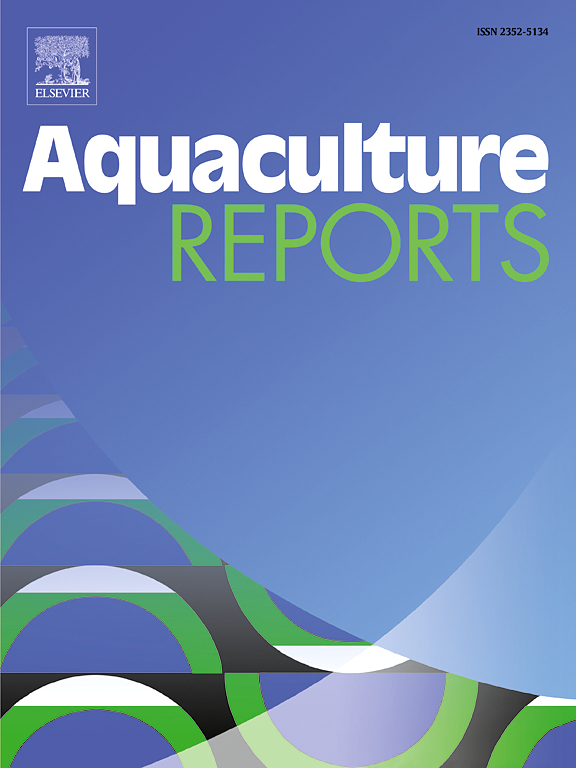Divergent molecular responsive mechanism of female and male spotted scat (Scatophagus argus) liver to 17β-estradiol revealed by the comparative transcriptome analysis
IF 3.2
2区 农林科学
Q1 FISHERIES
引用次数: 0
Abstract
Spotted scat (Scatophagus argus), an economically significant marine fish species, is widely distributed along the coasts of Guangxi, Taiwan and Guangdong Province in China. It exhibits sexual growth dimorphism, with females exhibiting a faster growth rate and larger size than males. The critical metabolic organ liver plays an important role in regulating body growth and reproduction processes, which that are influenced by estrogens. In this study, the molecular mechanisms of 17-estradiol (E2) regulates body growth and reproduction in livers were investigated by transcriptome sequencing, after fed 2-year-old spotted scat with E2-containing baits for 30 days. Transcriptome analysis identified 218, 1949, 548, and 1718 differentially expressed genes (DEGs) (FDR < 0.05 and |log2(FC)| ≥ 1) in livers of spotted scat across the Ctrl-ML vs. Ctrl-FL, E2-ML vs. E2-FL, E2-ML vs. Ctrl-ML, and E2-FL vs. Ctrl-FL groups, respectively. The amino sugar and nucleotide sugar metabolism pathway was significantly influenced in females by E2. While fatty acid metabolism, arginine and proline metabolism were significantly enriched in males. Several genes metabolic (acsl5, gpx1b, and nots), growth and reproduction-related genes (igfs, vtgs, erα, and zps) were responded to E2 in a gender-specific manner. Thus, the livers of females appeared to be more sensitive to E2 feeding than males, and the responsive mechanisms of spotted scat livers to E2 were gender-specific. These findings will provide a foundation for understanding the molecular regulation of estrogen in fish growth and reproduction within the liver, and will also offer theoretical evidence for the artificial cultivation of spotted scat.
比较转录组分析揭示了雌雄斑点粪便肝脏对17β-雌二醇不同的分子反应机制
斑点鱼(Scatophagus argus)是一种具有重要经济价值的海洋鱼类,广泛分布在广西、台湾和广东沿海。它表现出两性生长的二态性,雌性的生长速度比雄性快,体型比雄性大。肝脏是重要的代谢器官,在调节受雌激素影响的机体生长和繁殖过程中起着重要作用。本研究通过转录组测序研究了17-雌二醇(E2)调控肝脏中机体生长和繁殖的分子机制。转录组分析鉴定出218、1949、548和1718个差异表达基因(deg) (FDR <;在Ctrl-ML组与Ctrl-FL组、E2-ML组与E2-FL组、E2-ML组与Ctrl-ML组、E2-FL组与Ctrl-FL组、斑点粪便肝脏中|log2(FC)|≥ 1)的差异分别为0.05和0.05。E2显著影响了雌性的氨基糖和核苷酸糖代谢途径。而脂肪酸代谢、精氨酸和脯氨酸代谢在雄性中显著增加。一些基因代谢(acsl5, gpx1b和nots),生长和生殖相关基因(igfs, vtgs, erα和zps)以性别特异性的方式响应E2。由此可见,雌性肝脏对E2摄食似乎比雄性更敏感,斑粪肝脏对E2的反应机制具有性别特异性。这些发现将为进一步了解雌激素在鱼类肝脏内生长和繁殖中的分子调控奠定基础,并为斑点鱼的人工养殖提供理论依据。
本文章由计算机程序翻译,如有差异,请以英文原文为准。
求助全文
约1分钟内获得全文
求助全文
来源期刊

Aquaculture Reports
Agricultural and Biological Sciences-Animal Science and Zoology
CiteScore
5.90
自引率
8.10%
发文量
469
审稿时长
77 days
期刊介绍:
Aquaculture Reports will publish original research papers and reviews documenting outstanding science with a regional context and focus, answering the need for high quality information on novel species, systems and regions in emerging areas of aquaculture research and development, such as integrated multi-trophic aquaculture, urban aquaculture, ornamental, unfed aquaculture, offshore aquaculture and others. Papers having industry research as priority and encompassing product development research or current industry practice are encouraged.
 求助内容:
求助内容: 应助结果提醒方式:
应助结果提醒方式:


